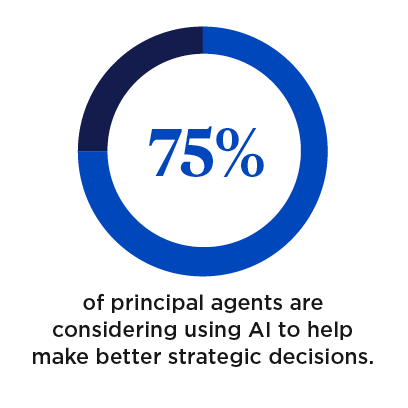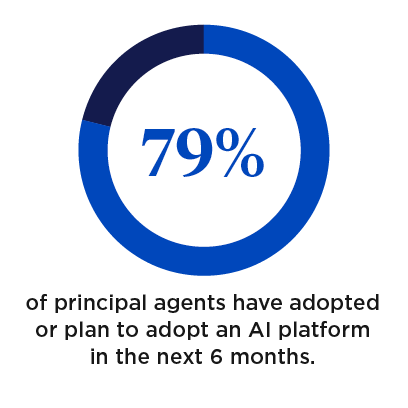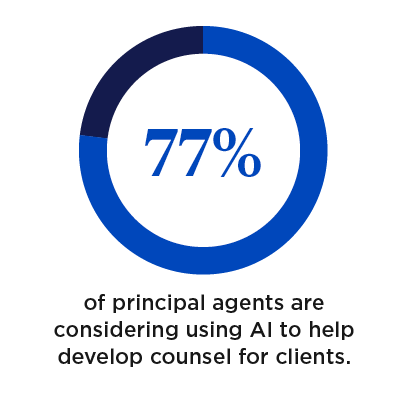Actionable AI: A guide for insurance agents
Advancements in insurance technology and evolving client expectations are shaping the changes the industry needs to adopt. With the potential efficiency gains through automation, machine learning and now generative artificial intelligence (AI), it may be time to introduce, or revisit integrating these technologies into your business to deliver improved client experiences. According to global research and advisory firm Forrester1, generative AI is being widely adopted and explored by enterprises and consumers alike, and it will have a significant impact on business processes and customer expectations in 2024 and beyond. Consider from just a little over a year (Sept. 2022 – Aug. 2023), ChatGPT had 14.6 billion visits and currently has over 180 million users2. Not to mention other AI tools gaining popularity like Google Gemini, Microsoft CoPilot and many more.
When it comes to gen AI, from summary capabilities, text-to-image or video generators, coding and customer service assistance, it’s easy to get lost in the many possible use cases and new applications. This guide will walk through the basics of understanding and getting started with AI.



“Gen AI will change the way we work, helping to automate routine tasks and free employees up to do their best work. Embracing this tool now will set IAs and their businesses up for success.”
-Jim Fowler, Nationwide Chief Technology Officer
Part 1: Understanding AI and its role in insurance
Actionable AI Glossary
Artificial intelligence: Leverages computers and machines to mimic the problem-solving and decision-making capabilities of the human mind
Traditional AI: Focuses on analyzing historical data and making future numeric predictions. As AI evolves, there are maturity levels with differing levels of complexity:
- General AI: Systems that comprehend, learn, and perform intellectual tasks much like humans.
- Narrow AI: Systems that are designed to complete a specific task.
Generative AI: Refers to the type of algorithms that can create content, such as text, images, or videos, by learning patterns from a given dataset and generating new, similar instances of data.
Machine Learning (ML): A subset of AI that allows computers to learn from data and improve their performance over time without being explicitly programmed.
Natural Language Processing (NLP): A field of AI that focuses on the interaction between computers and human languages. It enables computers to understand, interpret, and generate human language in a valuable way.
Large Language Models (LLM): A type of machine learning model that can understand and generate human-like language. It works by estimating the probability of a word or sequence of words occurring within a longer sequence of words. LLMs are trained on immense amounts of data, making them capable of performing a wide range of tasks such as generating text, translating languages, and answering questions.
Nationwide’s AI journey
With the recent buzz around generative AI, it’s easy to think the tech seemingly appeared out of nowhere, but at Nationwide AI and machine learning have been utilized for over a decade. The journey continues as Nationwide tests applications where it will best help us live into our mission of protection.
One example is the P&C Claims Log Summary proof of concept. When a customer calls our Claims Contact Center, associates can trigger a GenAI model to review the claim history and provide a summary of the claims and any actions that have been taken to date, allowing the associate to quickly pivot from researching the claim into answering customer questions.
Another example is through the launch of Nationwide Pet HealthZone. This platform incorporated generative AI to develop personalized information about specific pet health risks using claims data.
Read about Nationwide’s AI journey
How AI is transforming the insurance industry
Read about how AI is transforming the insurance industry
Leveraging AI in insurance: Unraveling its benefits and opportunities
Along with the opportunities and benefits of integrating AI, it’s essential to recognize its limitations and the importance of human judgment alongside AI, and the guidelines for managing risks.
Read about leveraging AI in insurance
Navigating the AI wave: New breakthroughs and economic trends
Nationwide’s Chief Technology Officer Jim Fowler and Chief Economist Kathy Bostjancic discuss recent breakthroughs and economic trends related to AI and the impact this is having on business strategy.
Listen to Economic Insights by Nationwide podcast
Part 2: Getting started with AI
Evaluating where to use
Now that you have an understanding of the opportunities with AI, it’s important to identify where it makes sense in your business. As with any part of your technology strategy, it should be done thoughtfully with the bigger picture of your agency in mind. Walk through these four fundamental questions about your agency to help simplify your decisions.
After identifying your needs, made simplified and concise with those fundamental questions, you can take the next step in the technology journey and learn ways to select the AI technologies that will deliver on your goals.
Follow these four process mapping steps as you next step:
- Account for the accountable
- Tally the tasks
- Fortify the future state
- Vet the vendors
Building a robust AI foundation
Once you’ve evaluated your current technology, the next step is to prepare your tech stack to leverage AI’s potential and focus on continuous workforce training to cultivate the efficient and responsible use of AI.
Read about building an AI foundation
Gen AI for Business 101
Nationwide’s Chief Innovation and Digital Officer Chetan Kandhari provides insights into what companies need to consider before implementing Generative AI.
Watch: Should my business use Generative AI?
Part 3: Continuing the journey with AI
With the rapid speed of this new technology, we know there’s still much to learn and discover. How can you remain at the forefront of AI advancements? Here are some strategies:
Continuous learning
- Participate in industry conferences: Tech-centric sections of insurance conferences can provide deep insights into the latest AI trends.
- Online courses: Websites like Coursera or edX offer courses specifically designed to help you understand AI’s role in insurance.
Networking
- Join professional groups: Social platforms like LinkedIn have groups dedicated to AI in insurance, serving as hubs for sharing insights and developments.
- Cross-industry engagement: Engage with professionals from the tech industry to understand the capabilities and limitations of current AI tools.
Research and development
- In-house experiments: Conduct pilot projects with AI tools to understand their practical application and impact on your business.
For the insurance industry, the shift towards AI has the capability to aid with greater efficiencies, better risk management, and superior client experience. By staying informed about AI technologies, you’re not just adapting to the current trends but preparing for a future where automation and human expertise interlace to shape the next era of the insurance industry.
Citations/Disclaimers
-
June 2024 Nationwide Economic Impact findings

